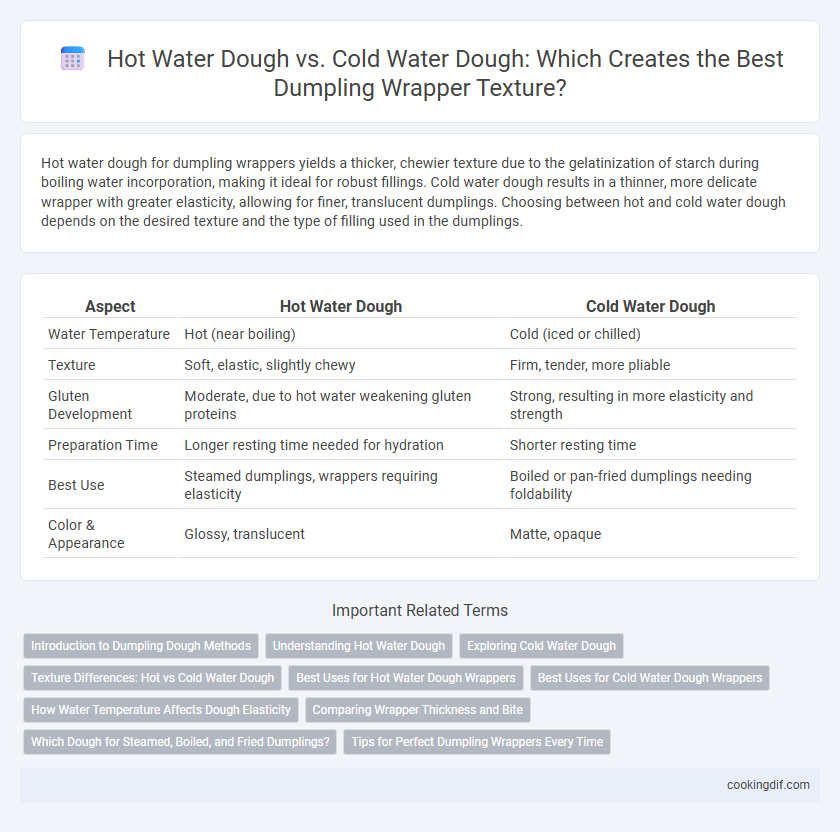Hot water dough for dumpling wrappers yields a thicker, chewier texture due to the gelatinization of starch during boiling water incorporation, making it ideal for robust fillings. Cold water dough results in a thinner, more delicate wrapper with greater elasticity, allowing for finer, translucent dumplings. Choosing between hot and cold water dough depends on the desired texture and the type of filling used in the dumplings.
Table of Comparison
| Aspect | Hot Water Dough | Cold Water Dough |
|---|---|---|
| Water Temperature | Hot (near boiling) | Cold (iced or chilled) |
| Texture | Soft, elastic, slightly chewy | Firm, tender, more pliable |
| Gluten Development | Moderate, due to hot water weakening gluten proteins | Strong, resulting in more elasticity and strength |
| Preparation Time | Longer resting time needed for hydration | Shorter resting time |
| Best Use | Steamed dumplings, wrappers requiring elasticity | Boiled or pan-fried dumplings needing foldability |
| Color & Appearance | Glossy, translucent | Matte, opaque |
Introduction to Dumpling Dough Methods
Hot water dough creates a softer, more pliable dumpling wrapper due to the gelatinization of starches during mixing, ideal for steamed or boiled dumplings. Cold water dough results in a firmer, chewier wrapper as the gluten develops more slowly, often preferred for fried or pan-fried dumplings. Understanding these dough methods allows for precise texture control in dumpling preparation, enhancing the overall eating experience.
Understanding Hot Water Dough
Hot water dough is distinguished by its preparation using boiling water, which gelatinizes the starches in the flour and creates a softer, more pliable texture ideal for dumpling wrappers that require elasticity and smoothness. This technique yields wrappers that are tender yet durable, preventing tearing during the wrapping and cooking process. Understanding hot water dough's unique composition helps achieve dumplings with a delicate bite and an appealing chewy consistency.
Exploring Cold Water Dough
Cold water dough for dumpling wrappers creates a chewier and more elastic texture compared to hot water dough, which tends to be softer and more tender. The use of cold water preserves the flour's gluten structure, resulting in a firmer dough that holds fillings well and withstands boiling without breaking. Dumpling enthusiasts often prefer cold water dough for wrappers when seeking a satisfying bite and durability in steamed or boiled dumplings.
Texture Differences: Hot vs Cold Water Dough
Hot water dough creates a wrapper with a smooth, tender, and slightly chewy texture due to the gelatinization of starch during boiling, making it ideal for dumplings that require a thicker, more elastic skin. Cold water dough results in a denser, firmer wrapper with a more doughy and less pliable texture, providing better structural integrity for dumplings that need to hold complex fillings or withstand frying. Texture differences between these doughs affect the dumpling's mouthfeel and cooking versatility, influencing the overall dining experience.
Best Uses for Hot Water Dough Wrappers
Hot water dough wrappers create a chewy and elastic texture ideal for potstickers and boiled dumplings, as the hot water gelatinizes the starch, enhancing pliability and strength during cooking. This dough performs best in recipes requiring wrappers that hold up well to steaming or boiling without becoming overly soft or tearing. Cold water dough, in contrast, yields a more tender and delicate wrapper suited for pan-fried or steamed dumplings that demand a lighter bite.
Best Uses for Cold Water Dough Wrappers
Cold water dough wrappers are ideal for delicate dumplings like jiaozi and xiao long bao, providing a tender yet elastic texture that holds fillings well. This dough retains moisture, making it perfect for boiling or steaming without becoming too tough or chewy. Its pliability ensures easy folding and shaping, resulting in consistently smooth and thin wrappers that enhance the overall dumpling experience.
How Water Temperature Affects Dough Elasticity
Hot water dough creates a softer, more pliable wrapper due to the partial gelatinization of starches, which reduces gluten development and enhances elasticity. Cold water dough allows for stronger gluten network formation, resulting in a firmer, chewier texture in dumpling wrappers. Water temperature directly influences the dough's elasticity by altering protein interactions and starch gelatinization, crucial for achieving the desired texture in dumplings.
Comparing Wrapper Thickness and Bite
Hot water dough produces dumpling wrappers that are thicker and chewier, providing a more substantial bite ideal for hearty fillings. Cold water dough creates thinner, more tender wrappers with a delicate texture that allows the filling's flavor to shine. The choice between hot and cold water dough directly influences wrapper thickness and bite, impacting the overall dumpling experience.
Which Dough for Steamed, Boiled, and Fried Dumplings?
Hot water dough, made by mixing boiling water with flour, creates a softer, more pliable wrapper ideal for steamed and boiled dumplings, as it maintains flexibility and softness after cooking. Cold water dough, mixed with room temperature water, results in a firmer, chewier texture that holds up well for fried dumplings, providing a crisp exterior while retaining structural integrity. Choosing the right dough depends on the cooking method to achieve the desired wrapper texture: soft and tender for steaming and boiling versus sturdy and crispy for frying.
Tips for Perfect Dumpling Wrappers Every Time
Hot water dough creates dumpling wrappers with a soft and chewy texture, ideal for steamed or boiled dumplings, while cold water dough yields a firmer, more elastic wrapper suited for pan-frying. For perfect dumpling wrappers, knead hot water dough until smooth and rest it for at least 30 minutes to enhance pliability. Use cold water dough when you need a stronger dough that can hold fillings without tearing, and allow adequate resting time to develop gluten for easy rolling and shaping.
Hot water dough vs Cold water dough for wrapper texture Infographic

 cookingdif.com
cookingdif.com